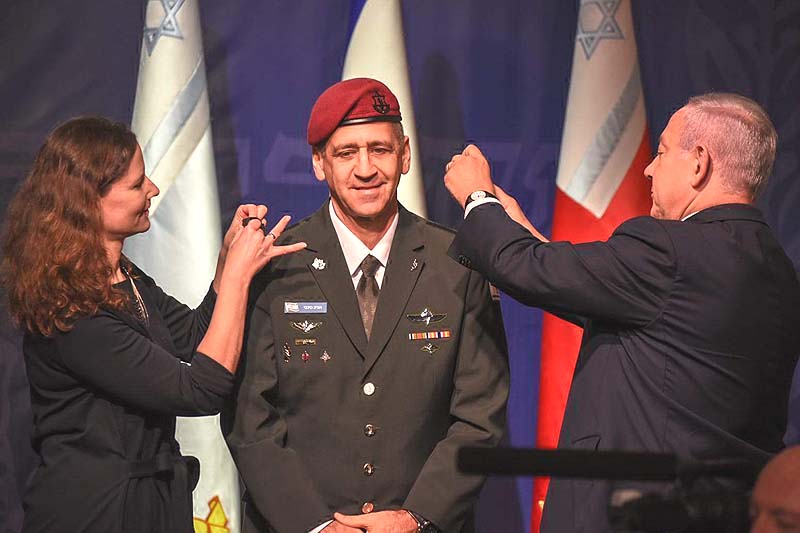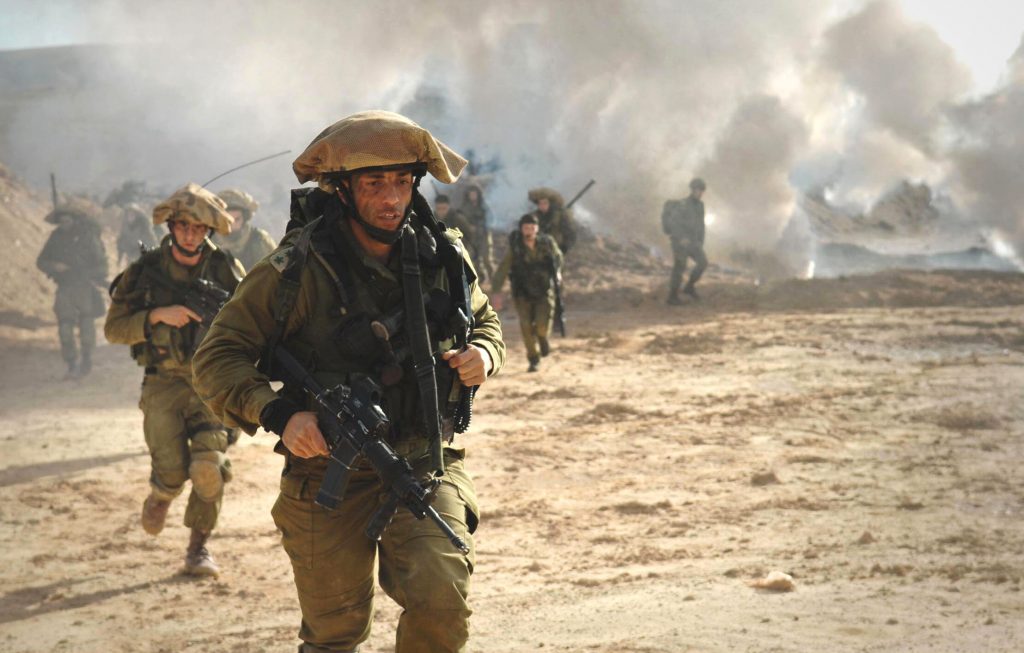Australia/Israel Review
Aviv Kochavi’s toughest assignment
Feb 4, 2019 | Amos Yadlin, Itai Brun & Udi Dekel

Ten challenges facing the new IDF Chief of Staff
On Jan. 15, 2019, Lt. Gen. Aviv Kochavi assumed his position as the 22nd IDF Chief of Staff. From a security perspective, his tenure begins in a stormy, unstable period, when the IDF’s strategic and operational environment continues to be marked by vast uncertainty.
The Position of Chief of Staff
According to Israeli law, the chief of staff holds the supreme command rank in the IDF, and is under the authority of the government and subordinate to the minister of defence. However, this brief (and vague) definition does not reflect the enormous scope of the position and its complexity. The IDF chief of staff is a national figure with a unique role that likely has no counterpart in other countries. The job requires the ability to take a broad strategic view – regional and global – of the war theatre, as well as an operational, overarching view of the various particular arenas. His main tasks are to direct the military as it takes on the challenges of the present and build up the military force that will ensure readiness and fitness for future challenges. These must occur while managing the current and emerging risks and maintaining public trust in the IDF.
Compounding the complex challenges inherent in the position are the political and social situations in Israel, as the country approaches general elections in April 2019. The circumstances of an election period stand to challenge the legitimacy of political decisions regarding security issues among some sections of the public. This, in turn, places a greater burden on the military and the chief of staff in particular, who is responsible to both the political level and the public for an objective and professional analysis of the situation. The political polarisation in Israel has the potential to intensify the public debate on which policies to adopt with respect to security challenges and cast doubt on the motives underlying political-security decisions.
What follows is a survey of the ten principal challenges that the incoming Chief of Staff will have to confront almost immediately.
1. The Iranian Threat: Nuclear and Conventional
Recent years have seen a growing sense in Israel that Iran represents the most significant threat to Israeli security. Until last year, Israel avoided direct military activity against Iran, but operated against it covertly while preparing an offensive option in response to the Iranian nuclear program. The withdrawal of the US from the nuclear agreement in May 2018 could lead to changes in Iranian policy regarding its nuclear program. It is therefore imperative to resume the discussion in principle regarding the purpose of the military option and the best way to implement it.
In the conventional context, the new Chief of Staff’s term begins with Israel and Iran – for the first time – in direct conflict, which includes Iranian casualties in a third arena: Syria. This situation demands a strategy that is able to clarify and maintain Israel’s red lines, without escalating hostilities in the northern arena. Direct confrontation between Israel and Iran could also lead to Iran’s use of force from its own territory against Israel. There is asymmetry in the capacity for action between Israel and Iran. Iran has considerable missile power that enables it to strike Israel, both from close to Israel and from its own territory. On the other hand, an Israeli attack on Iran would be a complex and highly risky operation.
2. Continued Offensive Activity in the Northern Arena
The “campaign between wars” strategy that Israel has successfully implemented in the northern arena, Lebanon and Syria, since 2013 has recorded some noteworthy achievements, particularly in delaying Iranian entrenchment in Syria and limiting transfers of weapons to the Lebanon-based terrorist group and Iranian proxy Hezbollah. However, after six years, it is important to examine whether a convergence of circumstances suggests that this formula for action in the north has reached its culminating point. Whether the strategy is now “overloaded” with risks and close to exhausting its ability to achieve its objectives without paying too heavy a price is worthy of debate.
A more fundamental debate about the overall benefit of the effort to prevent (or limit) the enemy’s attempts to enhance its conventional build-up, such as Hezbollah’s “precision missile project,” also appears necessary. Moving the project’s centre of gravity from Syria to Lebanon highlights the challenge faced by Israel and could lead to hostilities between Israel and Hezbollah, which for its part has clarified that its response to any attacks in Lebanon will be different from in the past.
3. Preparation for the “First Northern War”: Confrontation on Many Fronts
Since the Second Lebanon War in 2006, Israel and Hezbollah have maintained mutual deterrence regarding broad hostilities. However, experience shows the situation can deteriorate and might lead to a third Lebanon war, which would be more intense than its predecessors. The outcomes of the civil war in Syria also mean that such hostilities could occur in other arenas, different from those that have characterised fighting in recent decades.
The concept of “the first northern war” refers to the outbreak of military hostilities against Lebanon that could expand into Syria and even into Iran and Iraq (and in an extreme scenario, into the Palestinian arena as well), with the participation of various forces. This scenario not only involves stretching Israeli resources across several fronts, but also fundamentally undermines the concept of the use of Israeli force in the northern arena. As such, the familiar mechanisms for ending the fighting may no longer be relevant for such a complex operation, and therefore a different approach to the use of military force would be needed.
4. Force Buildup for “Decision” and “Victory”: Ground Manoeuvres
For several decades, the IDF has debated the current meaning of “decision” and “victory,” along with the possibility of achieving these goals through an updated operational approach. Underlying the debate is the question whether the clear, unambiguous result that typified the wars of the past is possible in contemporary wars.
The 2018 IDF Strategy responds to this question in the affirmative. It describes the newest concept of warfare as based on a multi-dimensional shock, combining precision fire (against thousands of planned and incidental targets) with rapid, lethal, and flexible ground manoeuvres. This concept regards such manoeuvres as an essential component and assigns them a significant role: to penetrate enemy territory and reach targets perceived as valuable.
However, in all recent hostilities, Israel has preferred to make use of its firepower capability by means of the air force and the artillery, and has been very hesitant and cautious about using its ground forces. The Chief of Staff must therefore ensure that the IDF does indeed have the practical ability for extensive ground manoeuvres, which is relevant against enemies such as Hezbollah and Gaza-based Hamas, and the ability to deal with a long process of overcoming social and political constraints on the use of military force.
In this context it would be right to continue a serious discussion of allegations by Maj. Gen. (ret.) Yitzhak Brick regarding the readiness of the ground forces. In view of the criticism, the incoming Chief of Staff must define what he expects from the ground forces, how to examine their fitness, and how to enhance it.

A key task will be ensuring the IDF is ready for ground warfare, and not relying on the air force and artillery
5. Hamas in Gaza
Like other fighting elements in the area, Hamas is not currently interested in a broad confrontation with Israel. However, more than four years after Operation Protective Edge, certain aspects of Israeli deterrence have been weakened. For example, Hamas today is more prepared to use force in circumstances that suit it – as reflected particularly in the escalation that occurred on Nov. 12-13, 2018, when over 500 rockets were launched at Israel.
Moreover, Israeli strategy toward the Gaza Strip suffers from an overload of objectives due to the basic features of the region (ongoing friction between the IDF and Gaza demonstrators along the border fence, the dire economic situation, the multiple rationales behind the actions of the civilian population, Hamas, and other factions active in the area) that reinforce the potential for escalation, and ultimately, hostilities. This situation demands of the IDF an operational plan in which the purpose justifies the price, whereby, in the event of a confrontation, the results include deterrence of Hamas for an extended period and damage to the organisation, with the emphasis on its military wing.
6. The West Bank: Preventing Deterioration
The current security situation in the West Bank is relatively stable and therefore justifies the continuation of existing military activity, with an effort to maintain the fabric of civilian life in the area. However, in the absence of a political decision regarding the Palestinian issue, the IDF must be operationally ready for the possibility of a sudden security collapse in this arena, due to potential developments whose timing and dynamics are hard to estimate or foresee. Foremost among these is the expected departure of Mahmoud Abbas from the political stage. This could lead to power struggles within Fatah or between Fatah and Hamas and even the collapse of the security framework in the area, including coordination between the IDF and the Palestinian Authority (PA) security apparatuses and/or broader violent outbursts by the Palestinian public against Israel or the PA itself.
7. Public Trust in the IDF: Managing Expectations
The National Security Index, a study of public opinion by the Institute for National Security Studies, shows that the Israeli public has extensive trust and confidence in the IDF, particularly with regard to matters perceived as professional and operational (preparations for military confrontations). However, the picture becomes more complex regarding the public’s attitude toward social and ethical perspectives that affect the IDF. There are considerable public disagreements over issues such as women’s military service, religion and the army, and even the rules for opening fire. This situation is a warning sign regarding the growing difficulty of distinguishing professional/operational matters from ethical, ideological, and political issues.
Another potential challenge to Israeli public trust in the IDF could emerge from the results of a broad military confrontation. The image of a decisive, unambiguous victory following a short lightning strike has survived the test of time and still has an enormous effect on how the Israeli public judges wars and their outcomes. Therefore, to the complexity and challenges that characterise current hostilities involving the IDF can be added ongoing frustration with the clear gap between image and reality, which could easily widen given the nature of future confrontations. The Israeli public understands that in war there are casualties, both military and civilian. However, it is doubtful whether the public today is mentally ready for a situation of enormous devastation in cities. A barrage of rockets and missiles with heavy payloads raining down on population centres could well cause severe and long term damage to the public’s sense of security. Thus, the public must be properly prepared in order to bring expectations more in line with results.
8. Civil-Military Relations: The Chief of Staff and the Political Echelon
In his book Supreme Command (2003), Eliot Cohen writes that military and political figures often find themselves in a relationship of cooperation that is highly tense and even confrontational. The Israeli experience certainly supports this assessment. Several Chiefs of Staff have reached a situation of severe friction with the politicians who have authority over them – from the hostility between Yigael Yadin and David Ben-Gurion (1949-1952) to that between Gabi Ashkenazi and Ehud Barak (2009-2011), and apparently also between departing Chief of Staff Gadi Eisenkot and former Defence Minister Avigdor Lieberman.
An important challenge for the Chief of Staff, therefore, is the need to clarify and regulate this complex set of relations. It is important to agree on what the “political echelon” means, and reach prior understandings regarding the nature of relations between the chief of staff and member of the “political echelon”: the prime minister (who is not even mentioned in the Basic Law: The Army, the key element of Israeli constitutional law governing the military); the defence minister (to whom the chief of staff is subordinate); the government (which has authority over the chief of staff); and the security cabinet. There is also a significant gap between the actual status of the prime minister and his legal status.
9. Relations between the Chief of Staff and the Regional Commanders
There is a persistent problem of relations between the chief of staff and the regional commanders. Past experience (including the Sinai Campaign, the Yom Kippur War, and the Second Lebanon War) indicates differences in perception between the chief of staff and the regional commanders, both with respect to planning processes and combat management. These differences can sometimes lead to direct confrontation between the chief of staff and a particular commander in a way that harms the effective conduct of operations. The recurrence of such cases shows that this is not just a problem of personalities, but a structural problem deeply embedded in the encounter between the chief of staff and the commanders, mainly because of their different perspectives. The incoming Chief of Staff must find a way to develop a shared system knowledge and conduct a dialogue in order to clarify the gaps, both in routine times and during emergencies.
10. The Budget Challenge
A central task for the new Chief of Staff is to continue an IDF build-up in the framework of a new long-term budget plan, which will replace the Gideon Plan (a five-year program launched in 2015 meant to streamline the military and ensure its preparedness for new types of conflicts ) in 2020. This plan must be approved by the government and include a multi-year budget. The plan’s stability depends on the stability of the national budget, and it appears that the conditions are ripe for reaching a decision regarding the definition of the security budget as a fixed percentage of GDP, providing a simple basis for calculation and avoiding arguments.
Conclusion
The supreme test of any chief of staff is war or a large military operation. Past experience shows that the possibility of war or a large military operation during the term of an Israeli chief of staff is highly likely. Since the tenure of Yitzhak Rabin (Chief of Staff during the Six Day War), wars or relatively large operations have occurred under the watch of nearly every chief of staff.
In this respect, the term in office of outgoing Chief of Staff Lt. Gen. Gadi Eisenkot was exceptional. It was a period of very intensive operational activity, but Israel managed to avoid embarking on a broad military operation, as this was perceived as contrary to its interests. What also made this period of relative calm possible was the mutual deterrence between Israel and Hezbollah after the Second Lebanon War, and between Israel and Hamas after Operation Protective Edge. Israel has used force against these two organisations in recent years, but has preferred not to let the situation deteriorate into total conflict. Hezbollah carried out its last attack, in which two soldiers were killed, in January 2015, just before Eisenkot assumed his post. When Hamas decided to escalate the hostilities with Israel in November 2018, it was Israel that preferred not to let the situation deteriorate.
Aviv Kochavi, the 22nd Chief of Staff, assumes his appointment at a sensitive, volatile time when the main elements that have shaped the relatively long period of calm are weakening. His responsibilities, therefore, are unquestionably among the most urgent and important in Israel’s current reality.






